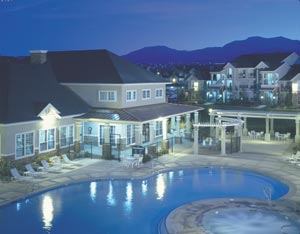Increased Density With less available land and prices steadily on the rise, developers are being forced to deal with smaller sites. Today’s typical garden building is approximately 150 feet to 160 feet long, with densities of 18 dua to 24 dua. By implementing new design ideas, the buildings are significantly reduced. Thus, they can be shortened 25 feet to 30 feet without effecting the net rentable footage.
A smaller, more efficient building will allow the developer to fit additional buildings on the site, consequently increasing the overall density of the project to yield 28 dua to 30 dua.
By using cost-saving construction techniques, owners can reallocate the savings into other areas, such as improving the site and amenities or even restructuring rents 4 cents to 10 cents per square foot lower than the competition. This increases the opportunity for an affordably constructed community to be competitive with class A products. Floor plans using cost-saving construction techniques should be equivalent in size as units found in luxury communities. In order to maintain a competitive edge, owners cannot afford to compromise on floor plan design.
Typical units designed for these communities offer a variety of one-, two-, and three-bedroom plans that range from 700 square feet to 1,500 square feet. The spacious, open plans are designed with numerous oversized windows for natural light, 9-foot and vaulted ceilings, arched doorways, art niches, and built-in computer desks and entertainment centers. Island kitchens and bathrooms, although they might be standardized to cut expenses, are luxurious and feature oval garden tubs, cabinetry with designer finish hardware, wine racks, and track lighting.
To further appeal to the needs of today’s renter, units can be designed to integrate multiple phone lines and high-speed Internet access.
Affordably constructed garden communities also can offer residents a variety of parking options that are both convenient and attractive. In addition to surface parking, the owner also can include private garages with remote control access and covered parking, while maintaining a parking ratio that yields 1.75 to 2 parking spaces per unit. In many cases, owners will capitalize on cost-saving construction techniques and invest the savings in site improvements and upgraded amenities.
Thornton, Colo., located just north of Denver, is experiencing a surge in population and job growth, thus the economic strength of the area has increased the demand for apartments. In order to stand apart from a myriad of new class A multifamily developments, Dermot Development Co., the owner of Champions Park, chose to focus on site improvements and offer resort-style amenities to obtain a competitive edge.
By using cost-saving construction techniques, Champions Park is able to contend in a class A market by offering luxury amenities combined with rents that are 4 cents to 5 cents per square foot below the competition. The community features a beautiful lake and a 7,000-square-foot clubhouse at the entry and includes large open green spaces, gazebos, a park with a playground, a picnic area with gas BBQ grills, a resort-style swimming pool and spa with fountains and waterfalls, car wash facilities, and storage units.
The need for quality affordably constructed multifamily housing is at an all-time high. The lack of reasonably priced and available land is forcing developers to find alternative design solutions that will allow communities to be built affordably and ultimately be financially successful. By addressing specific line items in construction and incorporating fresh design ideas, limited space can be maximized so that construction costs are reduced without compromising design goals.
The final product is an exciting, yet affordable, community that is able to compete with class A apartments in any market across the United States.
–Donald J. Meeks, AIA, is chairman of Meeks + Partners, an architecture and land planning firm in Houston.
